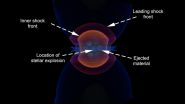(Press-News.org) A darting mouse may hold an important clue in the development of Attention Deficit Hyperactivity Disorder (ADHD), autism and bipolar disorder, according to a study by a Vanderbilt University-led research team recently published in the Proceedings of the National Academy of Sciences.
The transgenic mouse, into which was inserted a rare human genetic variation in the dopamine transporter (DAT), could lead to improvements in the diagnosis and treatment of these all-too-common brain disorders, said Randy Blakely, Ph.D., the report's senior author.
The mutation, which has been found in people with ADHD, autism and bipolar disorder, affects the function of DAT, a protein that regulates the brain's supply of the neurotransmitter by removing excess dopamine from the synapse, or the space between nerve cells.
The DAT mutation causes the transporter to become "leaky" and spew out dopamine like "a vacuum cleaner in reverse," said Blakely, Allan D. Bass Professor of Pharmacology.
While mice with leaky DAT proteins have too much dopamine hanging around their synapses, surprisingly they aren't particularly hyperactive, possibly because DAT can still remove some of the dopamine.
But the mice exhibit an unusual "darting behavior." While their wild-type littermates are docile and quite unresponsive when researchers pick them up, those with the mutation "take off."
"Early on," Blakely said, "we could tell which ones carried the mutation by observing this response." Heightened anxiety does not appear to be the cause.
Blakely and his colleagues wonder whether this behavior is a form of "impulsivity." Rather than acting on their memories of being picked up a lot, the mice are opting for an inappropriate escape strategy.
Normal mice also stand up a lot to explore their cage. This "rearing" behavior is exacerbated by stimulant drugs. But not in these mice.
"We wonder whether this may be a sign that their behavior is driven less by searching for clues to appropriate behavior versus acting on innate impulses," Blakely said.
Other, better tests of impulsivity that evaluate premature decision-making can be applied in rodents and humans. "These tests are next on our docket," he said.
The actions of amphetamine and methylphenidate (Ritalin) are also affected by the mutation. In normal animals and people without ADHD, the stimulants flood the synapse with dopamine, eliciting hyperactivity.
But when given to the mutant animals, the drug demonstrates a "blunted" effect on both dopamine release and on locomotor activation compared to normal animals.
Blakely wonders whether stimulants like Adderall and Ritalin quell hyperactive and impulsive behaviors in some children with ADHD by reducing inappropriate dopamine leak. "These mice may give us much better clues as to how these drugs are acting," he said.
To that end, Blakely recently received a five-year, $2-million grant from the National Institutes of Health (NIH grant number MH109054) to pursue explorations of these mice.
"Dopamine has classically been implicated in reward and the ability to detect novelty and to respond to pleasure and to engage in effective social interactions," he continued. The darting mice thus might shed light on a much broader spectrum of behaviors.
"We've got a lot to do," he said, "a lot of needy people (to help)."
INFORMATION:
Blakely credited Aurelio Galli, Ph.D., professor of Molecular Physiology and Biophysics, with whom he collaborated to identify the leaky properties of the mutant DAT protein.
Colleagues in the Vanderbilt Transgenic Mouse/ESC Shared Resource and Vollum Institute at Oregon Health and Science University in Portland made and helped study the transgenic mouse model, and first author Marc Mergy, Ph.D., received his doctoral degree in the Vanderbilt Neuroscience Training Program.
The study was supported in part by the Vanderbilt Silvio O. Conte Center for Neuroscience Research, which Blakely directs, and NIH grants MH090738, DA004523 and MH086530.
AUGUSTA, Ga. - A gene known to play a major role in constricting blood vessels also appears to be a major player in the aberrant blood vessel growth that can destroy the vision of premature babies.
Endothelin gene expression is greatly increased in the retinal tissue of a mouse model of retinopathy of prematurity, a condition that significantly affects about 1,500 infants annually, resulting in blindness in about half those babies, according to researchers at the Medical College of Georgia at Georgia Regents University.
The finding points toward a new therapy to help ...
Ann Arbor, MI, November 10, 2014 -- Public health researchers seeking to determine an individual's risk of developing cardiovascular disease (CVD), coronary heart disease (CHD), or stroke have previously relied on national US data, such as that provided by the National Health and Nutrition Examination Surveys (NHANES). Now, new data compiled and evaluated by researchers at the Centers for Disease Control and Prevention (CDC) provide information at the state level for the first time, paving the way for targeted intervention programs. Their results appear in the American ...
(Boston)--A new study has found it is possible to distinguish between different hemorrhagic fevers, including Marburg (Ebola cousin) and Lassa before the person becomes symptomatic.
The study, which appears in the journal BMC Genomics will allow for the development of better diagnostics, especially during the early stages of disease, when treatments have a greater chance of being effective.
Hemorrhagic fevers include Lassa, which is endemic in Western Africa and Marburg, which causes sporadic outbreaks in Africa associated with high rates of mortality. The early symptoms ...
Researchers from North Carolina State University and Hong Kong University of Science and Technology have found that temperature-controlled aggregation in a family of new semi-conducting polymers is the key to creating highly efficient organic solar cells that can be mass produced more cheaply. Their findings also open the door to experimentation with different chemical mixtures that comprise the active layers of the cells.
Polymer solar cells are a delicately controlled mixture of a polymer donor and a fullerene acceptor. The cell is created by adding a solvent to the ...
SEATTLE--Group Health patients with a positive screening test for colon cancer (a stool test or sigmoidoscopy) tended to be more likely to get the recommended follow-up test, a diagnostic colonoscopy, if nurse navigators contacted them than if they got usual care. This is according to "Results of Nurse Navigator Follow-up After Positive Colorectal Cancer Screening Test: A Randomized Trial" in the November-December Journal of the American Board of Family Medicine, led by Beverly B. Green, MD, MPH, a Group Health physician and a Group Health Research Institute associate investigator. ...
In research published today in the Astrophysical Journal, an Australian led team of astronomers has used radio telescopes in Australia and Chile to see inside the remains of a supernova.
The supernova, known as SN1987A, was first seen by observers in the Southern Hemisphere in 1987 when a giant star suddenly exploded at the edge of a nearby dwarf galaxy called the Large Magellanic Cloud.
In the two and a half decades since then the remnant of Supernova 1987A has continued to be a focus for researchers the world over, providing a wealth of information about one of ...
New York | Heidelberg, 10 November 2014 -- Physicists have, for the first time, explored in detail the time evolution of the conductivity, as well as other quantum-level electron transport characteristics, of a graphene device subjected to periodic ultra-short pulses. To date, the majority of graphene studies have considered the dependency of transport properties on the characteristics of the external pulses, such as field strength, period or frequency. The new findings have now been published in EPJ B by Doniyor Babajanov from the Turin Polytechnic University in Tashkent, ...
Philadelphia, November 10, 2014 -- Physician-patient communication about goals of care is a low risk, high value intervention for patients with a life threatening illness, the American College of Physicians (ACP) advises in a paper published in JAMA Internal Medicine.
"Discussions about end-of-life care, especially early in the course of a life-limiting illness, are associated with care more consistent with patient goals and improved patient outcomes, including longer survival rates and better quality of life," said Dr. David Fleming, president, ACP. "This approach is ...
Scientists believe a new treatment, shown to be effective in mice, could halt the growth of tumours in patients with prostate cancer.
Pioneering research, by academics at the Universities of Bristol, Nottingham and the University of the West of England (UWE Bristol), shows that a specific compound can inhibit the activity of a molecule which is key to how tumours form new blood vessels. The vessels are essential for the cancer cells to survive and multiply.
The findings, published today [10 November] in the journal Oncogene, show that targeting a molecule called SRPK1 ...
The sound of monitor alarms in hospitals can save patients' lives, but the frequency with which the monitors go off can also lead to "alarm fatigue," in which caregivers become densensitized to the ubiquitous beeping.
Researchers at Cincinnati Children's Hospital Medical Center have tackled this problem and developed a standardized, team-based approach to reducing cardiac monitor alarms. The process reduced the median number of daily cardiac alarms from 180 to 40, and increased caregiver compliance with the process from 38 percent to 95 percent.
"Cardiac monitors ...



